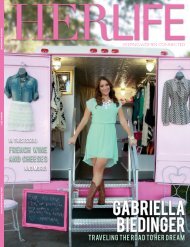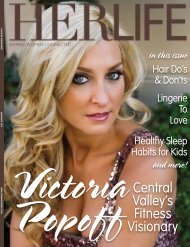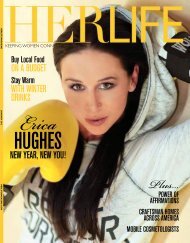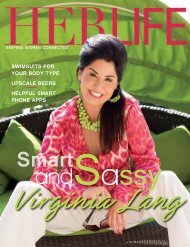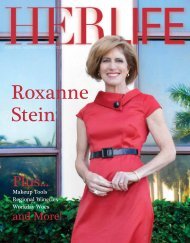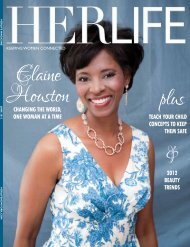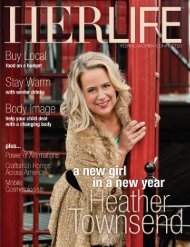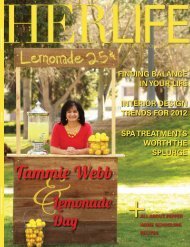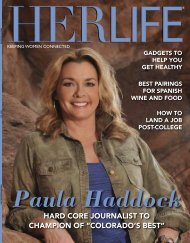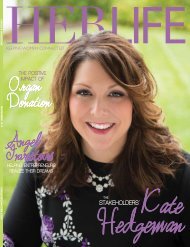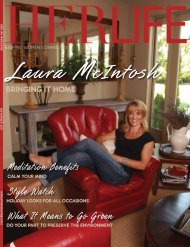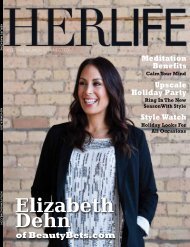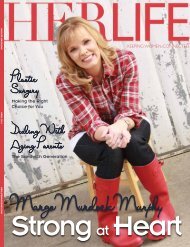Beth Myers - HERLIFE Magazine
Beth Myers - HERLIFE Magazine
Beth Myers - HERLIFE Magazine
Create successful ePaper yourself
Turn your PDF publications into a flip-book with our unique Google optimized e-Paper software.
herlife | green livingbeing greenwith babyby lisa taranto butlerAbaby may be born small, but her or his carbon footprintcan be huge from the get-go. Going green isn’t just foradults. Wee little babies make a huge environmental impacton their families and the world.From infancy to toddler age, a child can increase ahome’s garbage weight by 70 percent and power consumption byover 60 percent. And if that isn’t enough, parents may be drowning inthe extra 60 to 100 gallon water usage per month. So if you don’t gogreen for the sake of the environment, do it for yourself and your littleconservationist in the making.In The NurseryDesigning a natural nursery is neat. One of the best ways to treatyour environment sweet is to say “Yes” to those hand-me-downs.Used wooden cribs and rockers gifted from family and friends aregreat for the woods as well as your wallet. Shop thrift and antiquestores for well-built furniture that you can transform to your taste witha fresh coat of paint. Use the eco-friendly kind, good for baby and forthe atmosphere. Finish by upholstering with an earth-friendly fabricsuch as bamboo. Bamboo grass grows and can be harvested quickly,and it can be grown without fertilizer and pesticides.However, if you must have all-new baby gear, check out storeswith organic and natural choices such as sustainable timber coloredwith lead-free stains, hemp, silk and linen. Also, look to the ecologicalfuture and purchase a crib that turns into a toddler or full-sized bed.can be inserted for easier clean-up. But make sure to consider thebiggest environmental cost to cloth diapering–water consumption.Laundering soiled diapers adds up to about 50 gallons more wateruse per day.If your household decides on the eco-friendly path, you will havenew options. Eco-friendly diapers of the past were known to leak, butthese days options like chlorine, latex, gel and dye-free diapers arefairly easy to find, either at baby department stores or online. Flushableand biodegradable diapers are also good choices, but rememberthat the materials still have to break down over time, and the jury isstill out on how quickly this occurs.Compostable diapers sound like an environmental savior, but theability to turn a soiled diaper into sanitary, nutrient-rich dirt is hard tocome by. The technology works, but it’s not widely available. Checklocal stores or online to see if these diapers are available, and trythem for yourself.Breast FeedingExperts agree that breast is best for baby for numerous reasons,but when it comes to the environment, breastfeeding boasts lesstrash and plastic refuse compared to the waste left by formula cansand bottle supplies. The American Academy of Pediatrics (AAP)recommends that babies be exclusively breastfed for about the firstsix months of life, so imagine all the resources and money your familywill save.DiapersNo matter where you stand in the cloth versus disposable diaperdebate, environmentally friendly choices abound for both.If your choice is cloth, using cloth diapers doesn’t have to be apain-in-the rear, so to speak. Gone are the days of rectangular clothsand rusty safety pins. These days, reusable diapers are cut to atapered fit, offer easy-on/off Velcro closures and use light liners thatFoodHomemade baby food is a great way to guarantee healthy nutritionfor your hungry little one and lessen the load on the environment.While your grocer’s baby food requires excessive packaging andshipping, the stuff you make at home only “packs” a healthy punchand can save hundreds of dollars each year.To make your own baby food, simply steam veggies, blend in88 <strong>HERLIFE</strong>MAGAZINE.COM



